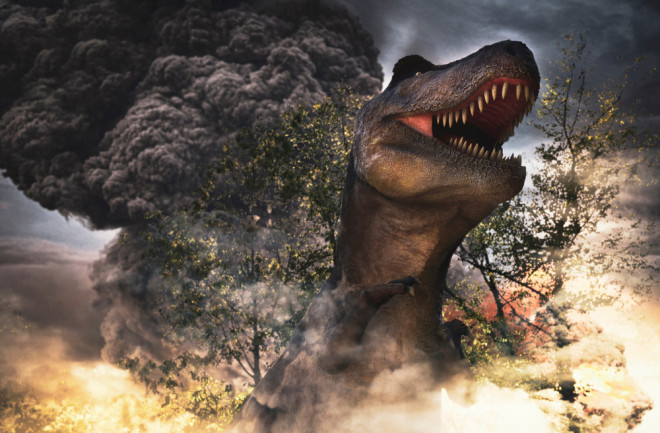It’s well known that an asteroid slamming into Mexico’s Yucatan Peninsula unleashed a catastrophic nuclear winter that ultimately killed off nearly three-quarters of life on Earth at the end of the Cretaceous period, about 66 million years ago. For years scientists have debated whether sulphur released on impact or soot from rampant wildfires acted as the ultimate extinction factor.
Now, in a study published earlier this year in the journal Nature Geoscience, a group of researchers argue that ultimately pulverized rock in the form of dust thrown up by the asteroid’s impact may have driven harsh climatic conditions. By blocking out sunlight, these tiny dust particles set the scene for swathes of life to be snuffed out post-impact — including the dinosaurs.
Where Did the Dust Plume Come From?
Researchers sought to understand the different role of sulphur, soot, and fine silicate dust on the earth’s climate and biodiversity following the impact.
Investigating a sediment layer in North Dakota, a team led by Cem Berk Senel, with the Royal Observatory of Belgium in Brussels, found large amounts of small, fine particles of silicate dust ranging from around 0.8 to 8.0 micrometers. These particles are remnants of the asteroid’s impact, which resulted in an enormous crater, now known as the Chicxulub crater.
Read More: Two Asteroids May Have Wiped Out the Dinosaurs
Senel and his team plugged their data into a paleoclimate model which indicated that a massive plume of these dust particles may have stayed in the atmosphere for as long as 15 years following the asteroid’s impact, ultimately plunging global temperatures by as much as 15° C during this time.
It's estimated around 2,000 gigatons of pulverized rock may have been released by the impact. According to Phillipe Claeys, a member of the study team with Vrije Universiteit Belgium, that figure is likely a “conservative” number.
How Did the Asteroid Impact Affect the Earth?
The most significant result, according to Senel, is that these sunlight-blocking particles led to a “global shutdown in photosynthesis” that lasted nearly two years after the asteroid slammed into Earth.
They used the model to compare the relative effects of sulphur, soot, and dust, with the latter clearly causing the most drastic changes. “In the case of sulphur and soot, we saw only regional or less significant responses in the photosynthetic shutdown, which lasted less than six months,” Senel says. “But in the silicate dust case, the global shutdown lasted almost 620 days, which could have caused severe challenges for life on Earth after the impact.”
The team’s findings suggest this particular “kill mechanism” may be the main driver behind one of Earth’s major extinctions, which led to the mass die-off of the non-avian dinosaurs. Contrary to other theories, which suggest that the post-asteroid extreme cold proved fatal to lifeforms, the team’s recent study suggests that disruption to photosynthesis was key following the asteroid strike, Senel explains.
Read More: Flowering Plants Survived the Dinosaur-Killing Asteroid
“That to us presented a different twist to the process of the extinction,” Claeys adds. Though they aren’t ruling out the part played by sulphur and wildfire-linked soot, they argue that it’s the fine dust particles that were crucial.
What Happens When Photosynthesis Stops?
The prolonged global disruption of photosynthesis most likely killed off vast amounts of plant life first. In turn the ensuing “dark, cold and food-deprived conditions” affected herbivore populations, and thus set off a chain reaction that hammered warm blooded animals and non-avian dinosaurs particularly hard. Populations not adapted to such conditions “would have experienced massive extinctions,” the authors write.
“A week or two after the impact, the dust would basically lead to a complete shutdown of photosynthesis,” says Claeys. “Plants are dead within a month and that would last up to two years. No plants growing, no food for the herbivores, no food for the carnivores and so on.”
“It doesn’t mean that all the organisms go extinct in those two years. But it means you have hit the food chain so hard that organisms like T. rex and Triceratops cannot continue,” he says.
Others that could adapt or enter into a dormant state also likely survived. “The ones that are the big winners are, of course, the small mammals,” Claeys says.
Senel aims to take the findings further. “In these paleoclimatic situations, we mainly focus on the short-term climatic and biotic responses, but we also want to know what happens in relatively longer timescales.”
Alongside dust, sulphur, and soot, the Chicxulub impact released other emissions such as methane and carbon dioxide, Senel says: “As a follow-up work, we want to understand their perturbations to the post-impact climate in longer timescales.”
Read More: The 5 Mass Extinctions That Have Swept Our Planet

